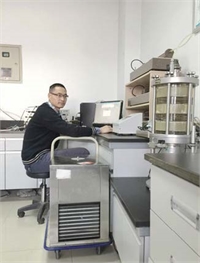Stress Path Triaxial (GDSTTS) with Temperature Control

The Civil Engineering Experiment Centre, within Nanjing Forestry University, is the provincial experimental teaching & demonstration centre in the Jiangsu Province of China. The University runs more than 50 scientific research programs and technology services. Their institutes include geotechnical and underground engineering research, road and bridge engineering, waterways, engineering surveying, mapping, green building and structural institutes. Test and research centres include, Jiangsu ZhengBen - nanlin research centre, the wooden structure research centre, the south forest engineering development services centre, surveying and engineering test centres as well as a civil engineering design centre. The Nanjing Forestry University work closely with many leading universities from the United States, Russia, Finland, Australia, Hungary, Singapore, Canada, Japan, France, Italy and other countries. The Civil Engineering Experiment Centre, within Nanjing Forestry University, is the provincial experimental teaching & demonstration centre in the Jiangsu Province of China.
Read below or Click here to download the case study.
THE PROBLEM
Mr Haibo Wang from Nanjing Forest University, has been teaching and involved with scientific research for many years. Having studied in Australia & China, Mr Wang has a good understanding of Geotechnical research within China and overseas. He is also the author of “Laboratory simulation on stress path of fiat dilatometer test based on advanced triaxial apparatus.” [J]. Journal of Nanjing Forestry University (Natural Science Edition) 2011,35(4):121-125 WPS-FA-EPS Thermal conductivity of WFS-FA-EPS fills, Chinese Journal of Geotechnical Engineering, 2010, 32(8), 1297-1302.).
The stress path test is commonly used to simulate the changing mechanical properties of soils, whilst under varying
|
stresses. Research in this area, within China and abroad has gradually increased. The static triaxial apparatus based on the Bishop-Wesley principle is widely accepted. However, in reality, the stress change of soil is usually accompanied by changes in the environment.
These environmental factors include changes in humidity, temperature and chemical invasion. Temperature change is the most common factor, in certain conditions the temperature changes can vary tens of degrees. Such variations are often accompanied by stress. What impact will this have on the mechanical properties of the soil? Will there be any difference when doing the same test on different soils? These are problems that Mr Wang was investigating. |
THE SOLUTION
In order to study these problems, Mr Wang’s local agent Earth Products China (EPC), with the guidance of GDS Instruments carried out some modifications to the standard GDS Stress Path Triaxial System (GDSTTS), which was previously purchased by the University.
The GDSTTS include a Bishop & Wesley stress path cell for 38/50mm diameter samples:
- Maximum cell pressure 1700kPa
- Maximum axial load 7kN
- Displacement transducer ±25mm
- 2MPa Pore Pressure Transducer
- GDS 8-channel, 16-bit data interface
- Pressure/Volume Controller for back pressure and cell pressure.
- It offers several software modules in order to smooth the whole test process.
Upgrades carried out on the apparatus included: Installation of a copper pipe in the cell, a transducer to monitor the temperature and a water bath to control the change in temperature. During the test, the temperature of the specimen was monitored by GDS’ software GDSLAB, as well as logging all the data.
|
Fig 1. GDS Stress path triaxial system
|
THE RESULTS
Following the temperature upgrades to the stress path apparatus, the scalability and opportunity for the test have changed. This transformation has expanded the scope of the laboratory stress path triaxial test. Nanjing Forest University have studied several kinds of soil with the upgraded apparatus. For every variation of soil tested, they have gathered invaluable knowledge. During the whole process, Nanjing Forest University have explored, modified, failed, explored, modified and ultimately achieve success. “Isn’t this the way to show the spirit of the scientific research process?” Quotes Mr Wang.
In addition, the apparatus has been upgraded to perform unsaturated testing. Future research may include this aspect in the test process, to obtain a test result, closer to the environmental condition of the soils.
|
 Fig 2. Triaxial stress path after temperature modification |
CONCLUSION & TESTIMONIAL
“During the whole process, experts from GDS Instruments and EPC China have provided great knowledge and service. They provide references for the transformation of the device according to their own experience. Also during the sensor selection and adaptation, they gave very professional advice. Their knowledge meant the sensors and devices connect seamlessly.
|
Not only was the original stress path triaxial system easy to use, it was easy to upgrade. The staff at GDS gave professional, high quality support throughout the process. Thus we hope to cooperate with GDS again in the future.” Mr Wang, Nanjing Forest University.
|
REFERENCES
XiaoBin Wang, Ping Yang, Haibo Wang, HaiMing Dai. Experimental study on the impact of freezing and thawing on the mechanical properties of clay [J]. Chinese Journal of Geotechnical Engineering. 2009(011): 1768-1772 (EI)
Haibo Wang, Ping Yang, Zhongyi H. E. Influence of porosity and saturation on thermal properties of silty soils [J]. Journal of Nanjing Forestry University (Natural Science Edition) 2012, 36(2): 42-46. (BY:CD)
ADDITIONAL APPARATUS
Nanjing Forestry University Civil Engineering Test Centre, also own the following GDS Apparatus:
- Advanced Dynamic Triaxial Testing System.
- Resonant Column System.
- Triaxial Automated System.
- Consolidation Testing System.
- Bender Element System.
They all play important role in the research and field testing at the university.
Featured Product
GDS Triaxial Testing System